

Golf
Golf, as
played today, finds its origin in Scotland. According to Scottish
historians, the first mention of the game dates from 1457. People
played with curved wooden clubs and spherical wooden balls. Playing
fields were streets, churchyards and open fields in and around the
Scottish towns. In winter, the players went on the links along the
seashore.

With
time, iron-headed clubs and composite wooden clubs replaced the
original ones. Leather balls, and in a later stage rubber balls,
replaced the wooden ones until the modern golf balls appeared on the
courses around 1900.
The essence of the golf game is to reach a target in the fewest number of strokes.
Originally, golf was a one-target team game in which two teams of two
players tried to reach a target in fewer strokes than the other team
(match play). So-called holes with a target divided the playing field
into several parts. One of the teams could win each hole played. The
team that won the most holes was the winner of the match.
Today, stroke play has become more popular. In stroke play, individual
golfers play all holes, and all the strokes made are added up. The
player with the fewest number of strokes for completing the ‘round’ of
holes is the winner.
In the second half of the 19th century, golf became popular in the
British Dominions, followed by North America and Western Europe. Today,
golf is one of the most popular sports in the world.
Read more ...
Publications on ancient golf
Publication |
Author |
Published (in) |
Golf ontstond in Nederland?  |
Geert & Sara Nijs |
2017 juli - Regio Golf Magazine 2014 juni - www.golfreiswijzer.nl, Golfreisnieuws nr. 264 |
The oldest picture of Scottish golf?  |
Geert & Sara Nijs |
2015 December - Through the Green (magazine of the British Golf Collectors Society) |
The Flemish and the game of golf  |
Geert & Sara Nijs |
2015 November - Posting on the blog of a major project of the University of St Andrews Institue of Scottish Historical Research, called 'Scotland and the Flemish people' |
All roads lead to Scotland  |
Geert & Sara Nijs |
2015 October - Saint RaphaŽl, France Presentation at the annual conference of the European Association of Golf Historians and Collectors |
| Collector Spotlight: Wayne and Claudia Aaron  |
Jim Davis |
2014 September - The GCS Bulletin 200th ISSUE (magazine of the Golf Collectors Society) |
| The Danish Golf Museum 25 years old  | Hans-Erik Duschek-Hansen | 2012 September - Golfika no. 10 (magazine of the European Association of Golf Historians and Collectors) |
| The transition of golf from a local game into a world sport  |
Geert & Sara Nijs |
2012 October |
The year 1457: golf or hockey?  |
Geert & Sara Nijs |
2009 September - Golfika no. 4 (magazine of the European Association of Golf Historians and Collectors) |
| Why did golf take so much time to integrate in continental society?  | Ab Bloemendaal | 2008 September - Golfika no. 3 (magazine of the European Association of Golf Historians and Collectors) |
De naakte waarheid over golf  |
Heiner Gillmeister |
2003 Sportimonium 23 |

The transition of golf from a local game into a world sport
Since the 'beginning' of golf (probably at the end of the 15th century or the beginning of the 16th century), the game remained for several centuries a local game mainly played in the eastern part of Scotland. The game remained unknown outside the Scottish borders. Contrary to the Flemings and the Netherlandish, not many Scots left their country other than as mercenaries for the European mainland.
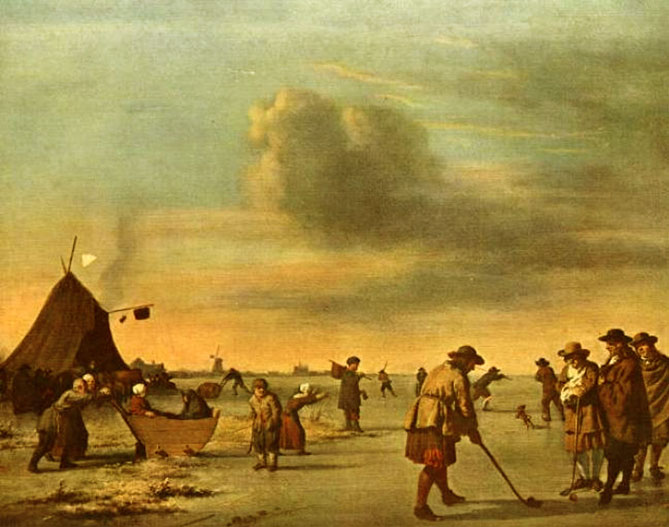
Scottish golfers playing colf on the ice near the Netherlandish city of Haarlem - Adriaen van de Velde, 1668
It took till the 17th century when Britain started to build its worldwide empire, that many Scots left their homeland:
- to act as merchants, colonists, officials and soldiers
- to populate the new colonies and trade settlements
- to extend and defend the British possessions and
- to secure the sea routes for their merchant navy against other seafaring nations, first Spain and Portugal and last but not least against the Northern Netherlands.
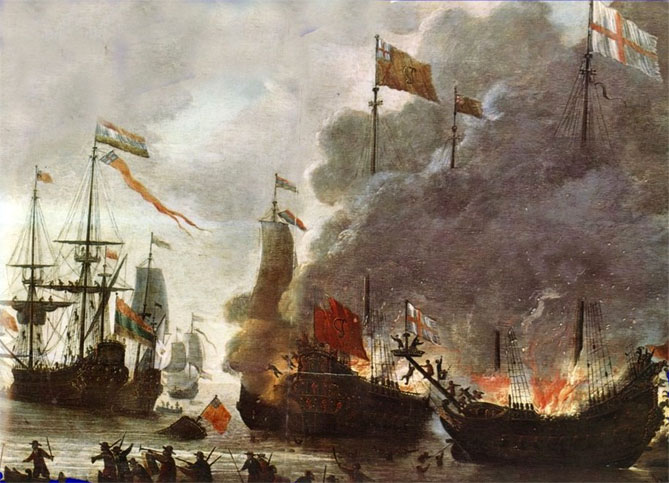
Sea battle between the English and the Netherlandish naval army. For many years in the 17th century and in many battles, they challenged each other for supremacy on the world seas. - Peter van de Velde, c.1670
The Scots, as soldiers, immigrants and expatriates, once avid golfers in their homeland, wanted to continue playing golf in and around the new British settlements. There are references to Scots ordering clubs and balls from Scotland. In the Scottish towns and villages, the unorganised golfers played friendly 'match play' matches, making up their own rules. The same happened in the new colonies and settlements.
When the British lost their American colonies (1776), officials, soldiers and many expatriates returned home to Britain, probably taking their golf clubs and balls back home as well. Consequently, the game of golf in the new United States of America lost much of its attraction.
Only in a few spots in the new nation did the remaining (Scottish) golfers try to survive.
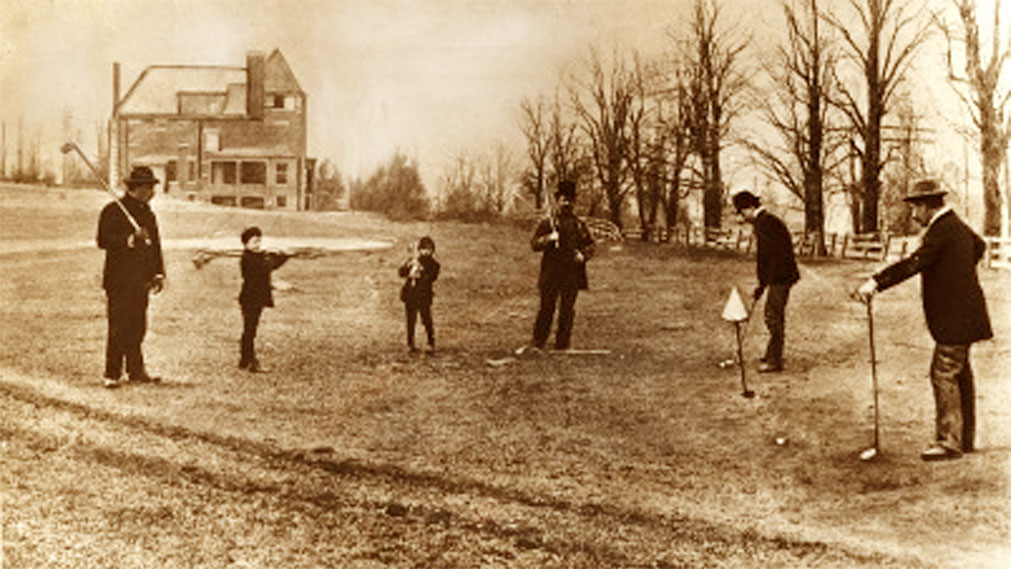
The first photograph from 1888 of 'modern' golf in the USA at St Andrews Golf Club of Yonkers. The course counted three holes. - http://www.yonkershistory.org
It took almost 70 years before John Reid more or less reintroduced golf in the USA. This Scottish immigrant, along with some of his friends, founded the 'St Andrews Golf Club of Yonkers', New York (1888). This foundation marks the official start of organised golf in the USA. However, it was not the first golf club on the North American continent.

A staged picture (1882) of the (Royal) Montreal Golf Club, founded in 1873. - http://www.rmgc.org
Fifteen years earlier, the Montreal Golf Club was established. The Royal (since 1884) owes its origins to a decision by eight men, then striking gutta-percha balls on Fletcher's Field in downtown Montreal, to form an independent golf club in 1873. Scottish-born Alexander Denniston was the first captain. Several documents prove that Scottish golfers in Canada played their game unorganised long before the official Montreal golfers. Already in 1826, there was a notice in the 'Montreal Herald' inviting fellow Scotsmen to come together to play golf.
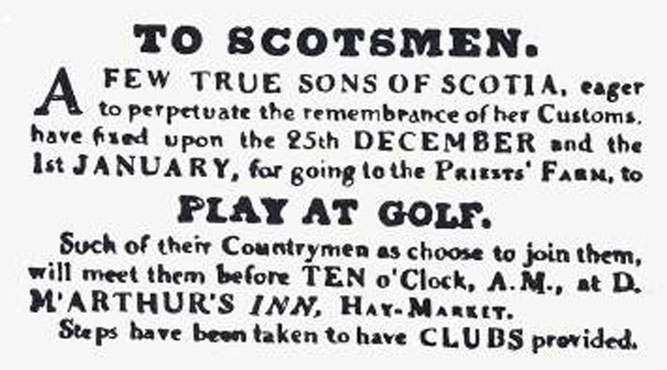
Advertisement in the Montreal Herald in 1826. It shows that before 1873, Scots played golf in Canada. - http://www.golfcanada.ca
All the other continents were ahead of the Americas in establishing more or less official golf clubs.
In Asia, the first golf club was founded in Calcutta, India, already in 1829 by British army officers. It is the oldest golf club in the world outside Britain.
Again, Scotsmen founded the oldest golf club in Europe and the first outside the British Commonwealth in 1856 in Pau, southwest France.
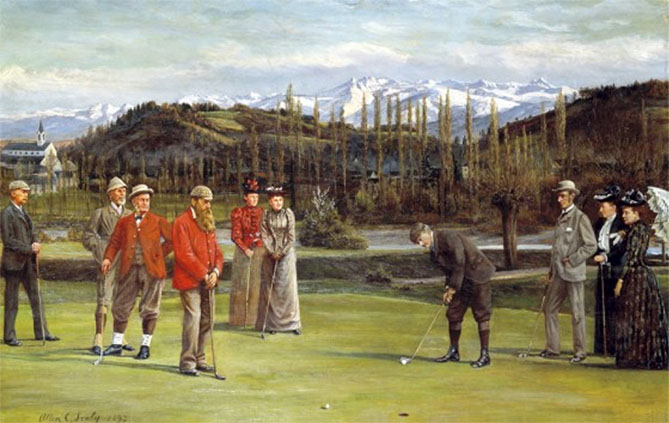
The well-known picture of Scottish golfers playing on the oldest course of the European mainland, the Pau Golf Club, founded in 1856. - http://www.paugolfclub.com
During the Napoleonic Wars, regiments of Wellington's army quartered in the Pau region in 1814. Some of the Scottish officers played golf in the fields around Pau. They appreciated the beautiful scenery and the mild climate. After their return to Scotland, some of them started to return with friends regularly to enjoy their holidays there. Over the years, more and more Britons decided to spend the winters in the Pau and Biarritz area, away from the cold and wet winters in their own country. In the years, an entire British colony settled in Pau. So, it does not surprise that the Duke of Hamilton and some friends founded the Pau Golf Club in 1856.
In Australia, the first golf club dates from 1882, the 'Australian Golf Club' in a suburb of Sydney. Legend has it that some officers of a Scottish regiment on leave from India played some golf in one of the parks in Sydney. It was usual that visiting officers became members of the social 'Union Club'. Perhaps the members of the Union Club were inspired by the officers and took up the game themselves, which resulted in the founding of the 'Australian Golf Club' in 1882.

The oldest known photograph of golf played in South Africa. Almost certainly taken in 1886, it shows General Torrens driving on the Waterloo Green Links, watched by Dr David Gill, in the brown suit and Colonel Curtis, Officer Commanding H.M. Cavalry in Natal. Printed on porcelain, Dr Gill presented the photograph to the Club shortly before returning to England in 1906. - http://www.royalcapegolf.co.za
In 1885, it was the turn of South Africa to found a golf club near Cape Town. On the 14th November, Lt General Henry Torrens, Governor of the Cape Colony, chaired a meeting "for the purpose of introducing the game of golf and starting a club for the same". And so it happened; the Cape Golf Club was founded.

General of the Gordon Highlanders in full dress. Thanks to Scottish officers, golf became a world sport. - http://peek-01.livejournal.com
The golf game spread its wings worldwide, mainly thanks to the Scottish officers in the British army and the many Scottish colonists. Until the end of the 19th century, the English hardly knew the game. Only the Scots loved to swing, wherever they could.
Nowadays, there are hardly any countries in the world where people do not play golf. Golf has become one of the most practised games and the most widely spread in the world.

